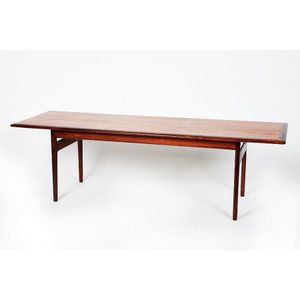Antique Refectory Dining Table with Drawer and Stretcher Base
You must be a subscriber, and be logged in to view price and dealer details.
Subscribe Now to view actual auction price for this item
When you subscribe, you have the option of setting the currency in which to display prices to $Au, $US, $NZ or Stg.
- Frieze - An architectural term denoting the flat, shaped or convex horizontal surface of furniture, between the architrave and the cornice, usually found on a cabinet or bookcase, or on desks and tables where it may include drawers, the area between the top and the legs. In ceramics, the term refers to the banding, of usually a repeating pattern, on the rims of plates and vases.
- Refectory Table - A long, substantial, solid-topped table, without leaves or extensions, used as a dining table. They were originally used in the refectories, or dining halls of monasteries, and are found in such places as boarding schools and university halls of residence. The tables usually have heavy turned legs, sometimes connected by stretchers close to the floor, and often have additional supporting legs along the railed frame. The term is also sometimes applied to a much shorter solid-topped table with a somewhat Jacobean flavour of the early 20th century.
- Stretcher - A horizontal rail which connects the legs of stools, chairs, tables and stands, to provide stabilisation of the legs. A stretcher table is any table with a stretcher base. The term is usually applied to substantial farmhouse tables, although many cabinetmaker's pieces, such as sofa tables, also have turned stretchers.
This item has been included into following indexes:
Visually similar items

A George III oak refectory table, 76 cm high, 232 cm wide, 82 cm deep

Mid- century coffee table, by Lane Altavista, in mahogany with dovetail detailing, length 138 cm, width 47 cm, height 37 cm

An oak refectory table, English, 19th century, 77 cm high, 223 cm wide, 68 cm deep

Attributed to Johannes Andersen (Danish), Coffee Table, c. 1960, manufactured by CFC Silkeborg, rosewood, retains manufacturer's label, height 50 cm with 165 cm depth 50 cm
